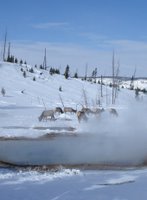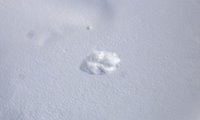 In 1995 and 1996, 31 gray wolves were realeased into the Yellowstone ecosystem. Ten years later, there are more than 250 wolves living in the Yellowstone area in around 30 packs, and more than 900 in the northern Rockies. In early February the U.S. Fish & Wildlife Service gave notice that it intends to remove the northern Rockies wolves from the endangered and threatened species list, subject to Wyoming developing an acceptable management plan for wolves (as Idaho and Montana already have done). Chris and I had dreamed of seeing a wolf in Yellowstone,
In 1995 and 1996, 31 gray wolves were realeased into the Yellowstone ecosystem. Ten years later, there are more than 250 wolves living in the Yellowstone area in around 30 packs, and more than 900 in the northern Rockies. In early February the U.S. Fish & Wildlife Service gave notice that it intends to remove the northern Rockies wolves from the endangered and threatened species list, subject to Wyoming developing an acceptable management plan for wolves (as Idaho and Montana already have done). Chris and I had dreamed of seeing a wolf in Yellowstone,  but we were under the impression that most sightings occurred in the northeastern part of the park, in the Lamar Valley. But now there are wolf packs throughout the park, as seen in this 2005 map from the park's web site. And when we arrived at Old Faithful, we learned that wolves had been spotted there recently, hunting for elk that gather in they geyser basins.
but we were under the impression that most sightings occurred in the northeastern part of the park, in the Lamar Valley. But now there are wolf packs throughout the park, as seen in this 2005 map from the park's web site. And when we arrived at Old Faithful, we learned that wolves had been spotted there recently, hunting for elk that gather in they geyser basins. On Day Three of our trip, we skied to Biscuit Basin and back on a cold day that started bright and turned blustery and gray. During our ski the day before, we hadn't seen a single mammal, so we were on the alert in the more promising terrain around the hot springs, where warm snow keeps the snow to a minimum, exposing grass for easy grazing. And sure enough, bison were everywhere. We were sitting in the trail eating lunch when this fellow appeared over the hill and marched right down the trail; we scrambled to get out of the way, and the bison didn't even glance at us as it marched over our lunch spot.
On Day Three of our trip, we skied to Biscuit Basin and back on a cold day that started bright and turned blustery and gray. During our ski the day before, we hadn't seen a single mammal, so we were on the alert in the more promising terrain around the hot springs, where warm snow keeps the snow to a minimum, exposing grass for easy grazing. And sure enough, bison were everywhere. We were sitting in the trail eating lunch when this fellow appeared over the hill and marched right down the trail; we scrambled to get out of the way, and the bison didn't even glance at us as it marched over our lunch spot. Less than a mile from Old Faithful, we saw our first wolf tracks. A straight line of saucer-sized paw prints—unmistakeable. The wolf had been walking along the boardwalk through the geyser basin and then jumped down to the snow. A few minutes later, we heard the wolves for the first time: low, almost moaning sounds, not quite a howl, definitely not the yips of coyotes. Soon we heard two separate groups on the ridge to our east. It seemed quite obvious that they were communicating.
Less than a mile from Old Faithful, we saw our first wolf tracks. A straight line of saucer-sized paw prints—unmistakeable. The wolf had been walking along the boardwalk through the geyser basin and then jumped down to the snow. A few minutes later, we heard the wolves for the first time: low, almost moaning sounds, not quite a howl, definitely not the yips of coyotes. Soon we heard two separate groups on the ridge to our east. It seemed quite obvious that they were communicating.
 We kept a sharp eye now, but we were not rewarded. (Well, other than seeing the geyser basins' other astounding sights and wildlife.) That night we went to a lecture by Dr. James Halfpenny, a renowned tracker and naturalist, about the wolf reintroduction project. Wolves, he said, live an average of only about 4.5 years in the wild; an 8-year-old is an old wolf. More than half the wolf deaths come at human hands (mostly those that wander outside protected areas and attack livestock), and one of the big fears is that wolves inside the park will become habituated to humans, like the black bears in Yosemite, leading to destructive encounters in which the wolves inevitably will be the losers. (The wolf program remains hugely controversial; Halfpenny showed us WOLFH8R and DIEWOLF license plates.) We learned that at least two people in the audience had seen wolves that morning, within a few hundred yards of where Chris and I had seen the tracks and heard the animals' calls. We had just missed them.
We kept a sharp eye now, but we were not rewarded. (Well, other than seeing the geyser basins' other astounding sights and wildlife.) That night we went to a lecture by Dr. James Halfpenny, a renowned tracker and naturalist, about the wolf reintroduction project. Wolves, he said, live an average of only about 4.5 years in the wild; an 8-year-old is an old wolf. More than half the wolf deaths come at human hands (mostly those that wander outside protected areas and attack livestock), and one of the big fears is that wolves inside the park will become habituated to humans, like the black bears in Yosemite, leading to destructive encounters in which the wolves inevitably will be the losers. (The wolf program remains hugely controversial; Halfpenny showed us WOLFH8R and DIEWOLF license plates.) We learned that at least two people in the audience had seen wolves that morning, within a few hundred yards of where Chris and I had seen the tracks and heard the animals' calls. We had just missed them. Next morning, we had to catch the Snow Coach at 9 a.m., but Chris and I gobbled down breakfast and ran back out to the geyser basin for a last look. We we were coming back along the boardwalk when Chris glanced behind her and said, "Look! A wolf!" Nope. It was only a big coyote, trotting across the warm volcanic sand and up onto the boardwalk. But the wolves are out there, and it was a joy to hear them; we are sure we'll be back to see them.
Next morning, we had to catch the Snow Coach at 9 a.m., but Chris and I gobbled down breakfast and ran back out to the geyser basin for a last look. We we were coming back along the boardwalk when Chris glanced behind her and said, "Look! A wolf!" Nope. It was only a big coyote, trotting across the warm volcanic sand and up onto the boardwalk. But the wolves are out there, and it was a joy to hear them; we are sure we'll be back to see them.
Saturday, February 25, 2006
Yellowstone Day Three: Wolves
Posted by
Dougald MacDonald
at
6:59 AM
![]()
![]()
Subscribe to:
Post Comments (Atom)






1 comment:
Wolves are amazing. It must have been some experience to hear them howling in the open terrain --
That's a whole new twist on having a bison for lunch.
That was a great read. Thanks for the link.
Post a Comment